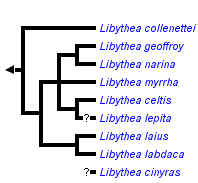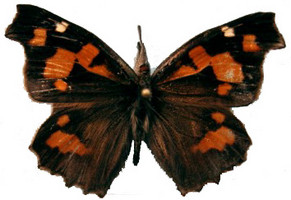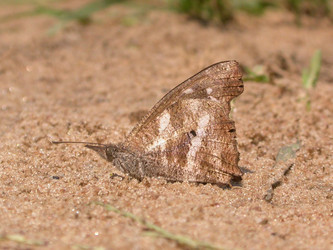Libythea
Akito Y. Kawahara, Niklas Wahlberg, and Andrew V. Z. Brower


This tree diagram shows the relationships between several groups of organisms.
The root of the current tree connects the organisms featured in this tree to their containing group and the rest of the Tree of Life. The basal branching point in the tree represents the ancestor of the other groups in the tree. This ancestor diversified over time into several descendent subgroups, which are represented as internal nodes and terminal taxa to the right.

You can click on the root to travel down the Tree of Life all the way to the root of all Life, and you can click on the names of descendent subgroups to travel up the Tree of Life all the way to individual species.
For more information on ToL tree formatting, please see Interpreting the Tree or Classification. To learn more about phylogenetic trees, please visit our Phylogenetic Biology pages.
close boxIntroduction
The genus Libythea includes nine extant species and two fossils. Adults typically land at damp spots on the ground, and visit flowers in low elevation mountains. The male typically is territorial, and both sexes cryptically rest on branches. Most species are found in forests and disturbed habitats, and usually have one or two annual generations. The egg is generally laid on buds of Celtis (Celtidaceae), and in nearly all cases, the larva feeds on leaves of this plant genus.
At least one non-fossil species is presumed extinct: Libythea cinyras Trimen, known only from the holotype specimen collected on Mauritius in 1866. The specimen is in poor condition, as it lacks a head and abdomen, and is stored in the type collection at the Natural History Museum in London. The life histories of L. collenettei Poulton & Riley (Marquesas Islands) and L. narina Godart (Southeast Asia) also remain unknown. For further information on the natural history of Libythea, refer to Kawahara (2006).
Characteristics
Species of Libythea share at least seven characteristics that can be used to distinguish them from Libytheana (Kawahara, in press):
- R3 of forewing with base closer to fork of R4+R5 than discal cell
- band between forewing M1 and M3 closer to wing margin than discal cell
- quadrifid eighth abdominal tergum
- saccus narrow and pointed anteriorly
- aedeagus sigmoid
- enlarged female seventh abdominal sternum
- signa present on inner surface of corpus bursae
Discussion of Phylogenetic Relationships
Phylogenetic relationships of Libythea species still remain somewhat tentative. Morphological data strongly support the relationships of the following groups: (Libythea celtis , Libythea lepita)(Libythea geoffroyi , Libythea narina)(Libythea labdaca , Libythea laius), but the placement of Libythea cinyras, Libythea collenettei, Libythea myrrha, and the two fossil taxa remain uncertain.
Other Names for Libythea
- Lybithea
- Hecaerge
- Chilea
- Libythoea
- Hypatus
- Libythaeus
- Hecaaerge
- Libythaea
- Lybathea
- Dichora
- Libytahe
- Libethea
References
Kawahara, A. Y. 2006. Biology of the snout butterflies (Nymphalidae: Libytheinae), Part 1: Libythea Fabricius. Transactions of the Lepidopterological Society of Japan 57(1): 13-33.
Kawahara, A. Y. (accepted). Revision of the Extant and Fossil Snout Butterflies (Lepidoptera: Nymphalidae: Libytheinae). Thomas Say Publications in Entomology, Monographs. Lanham, Maryland.
Title Illustrations

| Scientific Name | Libythea celtis |
|---|---|
| Location | Barcelona, Spain |
| Specimen Condition | Dead Specimen |
| Identified By | Niklas Wahlberg |
| Life Cycle Stage | Adult |
| Image Use |
 This media file is licensed under the Creative Commons Attribution-NonCommercial License - Version 3.0. This media file is licensed under the Creative Commons Attribution-NonCommercial License - Version 3.0.
|
| Copyright |
© Niklas Wahlberg

|
| Scientific Name | Libythea labdaca |
|---|---|
| Location | Luki, near Boma, Democratic Republic of Congo |
| Specimen Condition | Live Specimen |
| Identified By | Akito Y. Kawahara |
| Behavior | Resting on ground |
| Sex | Male |
| Life Cycle Stage | Adult |
| Body Part | Entire |
| View | Lateral |
| Collection | Akito Y. Kawahara |
| Collector | Akito Y. Kawahara |
| Image Use |
 This media file is licensed under the Creative Commons Attribution License - Version 3.0. This media file is licensed under the Creative Commons Attribution License - Version 3.0.
|
| Copyright |
© Akito Y. Kawahara

|
About This Page
Akito Y. Kawahara

University of Maryland, College Park, MD, USA
Niklas Wahlberg

University of Turku, Finland

Middle Tennessee State University, Murfreesboro, Tennessee, USA
Correspondence regarding this page should be directed to Akito Y. Kawahara at , Niklas Wahlberg at , and Andrew V. Z. Brower at
Page copyright © 2009 Akito Y. Kawahara, Niklas Wahlberg, and
All Rights Reserved.
- First online 25 September 2006
- Content changed 18 May 2009
Citing this page:
Kawahara, Akito Y., Niklas Wahlberg, and Andrew V. Z. Brower. 2009. Libythea . Version 18 May 2009 (under construction). http://tolweb.org/Libythea/12184/2009.05.18 in The Tree of Life Web Project, http://tolweb.org/









 Go to quick links
Go to quick search
Go to navigation for this section of the ToL site
Go to detailed links for the ToL site
Go to quick links
Go to quick search
Go to navigation for this section of the ToL site
Go to detailed links for the ToL site